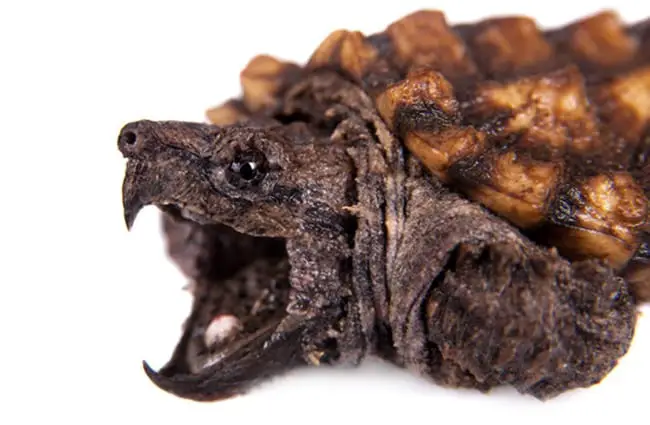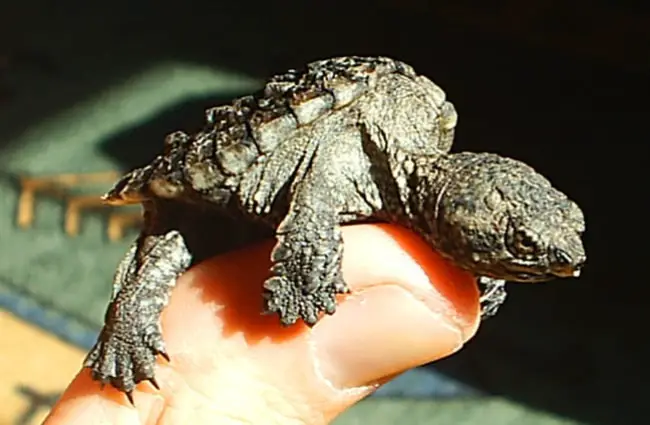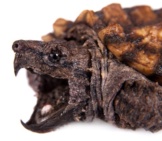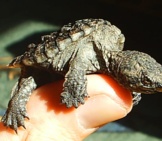Snapping turtles are large, freshwater species of aquatic turtles that are known for, well, snapping. They have powerful jaws and sharp beaks that are known for their characteristic ability to snap closed with incredible speed.
There are two living species of snapping turtle, the common, and the alligator. The largest species, the alligator snapping turtle, is also one of the heaviest freshwater turtle species in the world. Read on to learn about the snapping turtle.
Description of the Snapping Turtle
The two species of snapping turtle, though not closely related, have somewhat similar morphology. The primary difference between the two is the smooth shell of the common, and the spiky dorsal ridges of the alligator.
Both species have thick heads with sharp, pointed beaks that are used to kill prey. Their namesake comes from their ability to snap those sharp beaks closed with incredible speed. Both species also have relatively long, thick tails for aquatic turtles.
Interesting Facts About the Snapping Turtle
Snapping turtles have a number of useful adaptations that help them survive and capture prey. There are also a few misconceptions about these creatures that tend to be spread in the media.
- Vermiform – Much like anglerfish, snapping turtles use a lure to attract potential prey. This lure is called a vermiform, and it looks and moves like a worm. Unlike anglerfish, snapping turtles use their tongue as their lure!
- Ambush! – The only reason this vermiform is useful is because these reptiles are ambush predators. This means that they can lie incredibly still for hours while waiting for prey to approach. By using their vermiform, they can lure their prey within snapping range.
- Extrapulmonary Respiration – While not all individuals undergo hibernation, those that do have some unique ways of surviving. The membranes in their mouths and throats are specially designed to allow them to acquire oxygen without breathing. Basically, if they have to, they can “breathe” underwater.
- Finger Food – Let’s get this fact out of the way first, yes, these turtles can easily bite off fingers. They do not, however, have record-breaking bite strength. While they should be avoided, or handled with extreme care, bites and mutilations are relatively rare.
Habitat of the Snapping Turtle
These turtles live primarily in freshwater, but will occasionally inhabit saltwater. They are common in lakes, ponds, streams, rivers, estuaries, and other, similar habitats. Their preferred habitats usually have a muddy bottom with plenty of substrate to dig beneath. They also prefer areas with plenty of places, such as fallen logs, to climb out of the water and bask in the sun.
Distribution of the Snapping Turtle
Both species of snapping turtles are native to North America, primarily the United States. The common species is relatively widespread, ranging from southeastern Canada in the north, to Florida in the south. Their range also spreads westward into Wyoming, Montana, and Utah. The alligator species has a more restricted range, and can be found from northern Florida, west to Texas, and north to Kansas.
Diet of the Snapping Turtle
These reptiles are mostly carnivorous, but will also feed on some plant matter. They are extremely opportunistic, and will eat just about anything that finds itself in their mouths, including carrion. Their most common prey species are other turtle species, fish, mollusks, frogs, insects, snakes, and small mammals. Some other recorded prey includes birds, crabs, muskrats, raccoons, squirrels, armadillos, and more.
Snapping Turtle and Human Interaction
One of the many pressures faced by these creatures is collection of young animals for the pet trade. They are prevalent as exotic pets, but should not be kept by inexperienced owners (unless you want to lose a few fingers.) They are also harvested for their meat, which is consumed in a number of southern states. Finally, habitat destruction and urbanization also pose a significant threat to these turtles.
Domestication
Neither of the two species has been domesticated in any way.
Does the Snapping Turtle Make a Good Pet
No, unless you are a highly experienced turtle keeper, these creatures do not make good pets. They have long necks, and are more than capable of biting, even when held from the sides of the shell. This can pose a danger to anyone caring for them.
Snapping Turtle Care
In a zoological setting, care must be taken when handling these creatures for the reasons mentioned here. They can also grow quite large, and should be kept in large tanks with plenty of space for growth. They do require areas to haul out of the water and bask as well. This turtle’s preferred diet is live fish, but they will eat just about anything that it is fed.
Behavior of the Snapping Turtle
As ambush predators, these reptiles spend long periods standing still, and short bursts capturing prey. Because they grow so large, they tend to have little fear of other creatures. They can even be quite inquisitive, and are known to approach people, or even to bump into them. For the most part, they will retreat from people, but can be aggressive when handled or approached on land.
Reproduction of the Snapping Turtle
In the southern parts of the country, reproduction takes place earlier, usually in early spring. Alligator snapping turtles lay anywhere from 10 to 50 eggs, while common snapping turtles lay 25 to 80 eggs. Both species bury the eggs in the sand on riverbanks. Incubation ranges by temperature, and can last anywhere from 9 to 20 weeks. The young are fully independent when they hatch.











![Red Angus Closeup of a beautiful Red Angus cowPhoto by: U.S. Department of Agriculture [pubic domain]https://creativecommons.org/licenses/by/2.0/](https://animals.net/wp-content/uploads/2020/03/Red-Angus-4-238x178.jpg)












![Red Angus Closeup of a beautiful Red Angus cowPhoto by: U.S. Department of Agriculture [pubic domain]https://creativecommons.org/licenses/by/2.0/](https://animals.net/wp-content/uploads/2020/03/Red-Angus-4-100x75.jpg)

